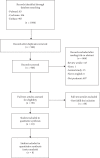Assessment of the Effectiveness of Vitamin Supplement in Treating Eczema: A Systematic Review and Meta-Analysis
- PMID: 31781276
- PMCID: PMC6875217
- DOI: 10.1155/2019/6956034
Assessment of the Effectiveness of Vitamin Supplement in Treating Eczema: A Systematic Review and Meta-Analysis
Abstract
Background: The morbidity of eczema has increased in the recent years, and the methods to prevent or ameliorate its effects are becoming more important. To this end, this research was conducted to determine the effectiveness of vitamin supplements in eczema therapy.
Method: Embase, PubMed, and Cochrane Central Register of Clinical Trials were searched. Only randomized controlled trials were included, and we included all quantified eligible data where the SCORing Atopic Dermatitis (SCORAD) Index or Eczema Area and Severity Index (EASI) scores were applied to assess the severity of eczema.
Results: Ten studies fulfilled the inclusion criteria, and eight of them were included for quantitative analysis (total: 456 patients). Compared to the controls, the SCORAD index or EASI decreased in the vitamin supplement group (mean difference -5.96, 95% CI: -7.69 to -4.23 for vitamin D3; mean difference -5.72, 95% CI: -11.41 to -0.03 for vitamin E; and mean difference -3.19, 95% CI: -4.27 to -2.10 for vitamin B12).
Conclusion: This study suggests that vitamin supplements could be important therapeutics to help manage eczema patients.
Copyright © 2019 Ziyu Zhu et al.
Conflict of interest statement
The authors declare no conflicts of interest.
Figures








Similar articles
-
Severity strata for Eczema Area and Severity Index (EASI), modified EASI, Scoring Atopic Dermatitis (SCORAD), objective SCORAD, Atopic Dermatitis Severity Index and body surface area in adolescents and adults with atopic dermatitis.Br J Dermatol. 2017 Nov;177(5):1316-1321. doi: 10.1111/bjd.15641. Epub 2017 Oct 1. Br J Dermatol. 2017. PMID: 28485036
-
EASI, (objective) SCORAD and POEM for atopic eczema: responsiveness and minimal clinically important difference.Allergy. 2012 Jan;67(1):99-106. doi: 10.1111/j.1398-9995.2011.02719.x. Epub 2011 Sep 27. Allergy. 2012. PMID: 21951293
-
Placebo responses in randomized controlled trials for systemic therapy in atopic dermatitis: A systematic review and meta-analysis.J Am Acad Dermatol. 2020 Jan;82(1):62-71. doi: 10.1016/j.jaad.2019.05.102. Epub 2019 Jun 13. J Am Acad Dermatol. 2020. PMID: 31202874
-
The effect of multistrain synbiotic and vitamin D3 supplements on the severity of atopic dermatitis among infants under 1 year of age: a double-blind, randomized clinical trial study.J Dermatolog Treat. 2022 Mar;33(2):812-817. doi: 10.1080/09546634.2020.1782319. Epub 2020 Jun 26. J Dermatolog Treat. 2022. PMID: 32530339 Clinical Trial.
-
Tripterygium agents for the treatment of atopic eczema: A Bayesian analysis of randomized controlled trials.Phytomedicine. 2019 Jun;59:152914. doi: 10.1016/j.phymed.2019.152914. Epub 2019 Apr 4. Phytomedicine. 2019. PMID: 30991183 Review.
Cited by
-
Associations of single and multiple vitamin exposure with childhood eczema: data from the national health and nutrition examination survey.Front Pediatr. 2024 May 15;12:1328592. doi: 10.3389/fped.2024.1328592. eCollection 2024. Front Pediatr. 2024. PMID: 38813547 Free PMC article.
References
LinkOut - more resources
Full Text Sources

